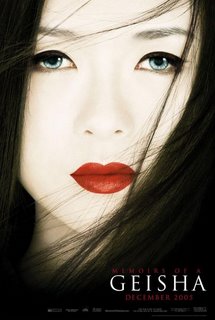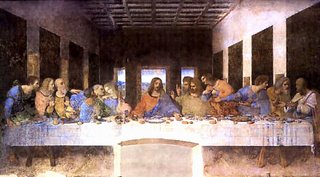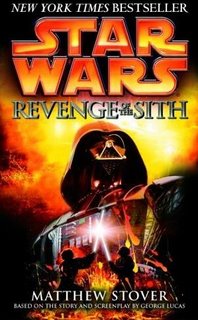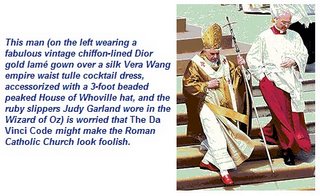An independent film maker and his take on piracy. This clip is so funny, I was in stitches. Enjoy! ;-)
Saturday, June 24, 2006
Friday, June 16, 2006
Memoirs
 I never really thought much of this book, some of my friends actually told me that it's a girlie book, usually meant for ladies to read and not for guys. Surprisingly, as fate would have it, I found the book sitting on the bookshelves as a traveller's book while staying at a hotel in Athens, Greece and took to reading it.
I never really thought much of this book, some of my friends actually told me that it's a girlie book, usually meant for ladies to read and not for guys. Surprisingly, as fate would have it, I found the book sitting on the bookshelves as a traveller's book while staying at a hotel in Athens, Greece and took to reading it.The book is written in a tell-tale and delicately-written style. It is very fluid and reads like a adult's bedtime novel. The book tells of the story of how the girl Chiyo, upon her mother's death bed, was sold into an okiya and later grew up to learn the ways of a geisha and became the most famous geisha Sayuri in Gion. Of course, she has an antagonist in the story in the form of Hatsumomo, who is a beautiful geisha, but recognised Chiyo's potential to surpass her in success and treated her cruelly.
I found this book to be childish at times, as it pitted one experienced geisha against a younger apprentice who was inexperienced, almost like a bully. Later in the novel when Sayuri became a famous and successful geisha, both (more on Hatsumomo's side) were trying to find ways to ruin each other's name constantly to compete for clients and money. It did become rather tiresome, but it was a nice cat fight to read to the end!
This novel is entirely fiction, but based on the real life accounts of the geisha, Mineko Iwasaki, who later sued the author Arthur Golden for breach of contract and defamation of character.
The best part of the book was in reference to a section where Mameha and Sayuri started to destroy Hatsumomo's reputation, and used a metaphor that meant that, if you start something, you have to finish it, especially when trying to destroy something or someone totally, completely and utterly!
On page 378, it reads:
"When you want to break a board, cracking it in the middle is only the first step. Success comes when you bounce up and down with all your weight until the board snaps in half."
I thought this metaphor summed up everything when you decide to be absolutely vindictive!
8 out of 10
Thursday, June 08, 2006
Tuesday, June 06, 2006
A Man's Oil
 The Da Vinci Code is a novel I first laid eyes on at a bookshop. I read the sypnosis and thought, hmm...this book sounds like a page-turner, and I was right, I read it within a day or so and was delighted at how sacrileges it turned out to be. Then I passed it to a colleague and she read it and her beliefs were shaken somewhat. It left her with the question of whether the novel was true as stated in the disclaimer at the beginning. I told her than anything is possible when it comes to religion.
The Da Vinci Code is a novel I first laid eyes on at a bookshop. I read the sypnosis and thought, hmm...this book sounds like a page-turner, and I was right, I read it within a day or so and was delighted at how sacrileges it turned out to be. Then I passed it to a colleague and she read it and her beliefs were shaken somewhat. It left her with the question of whether the novel was true as stated in the disclaimer at the beginning. I told her than anything is possible when it comes to religion. The book, however, is FICTION, the locations and churches are all real, perhaps Dan Brown should have revised his little disclaimer at the beginning of the book. Everything was interwoven into an beautiful and seamless tapestry that contains controversies which the Catholic Church vehemently denies. Jesus married Mary Magdalena and had a child. Their bloodline carries on till today with his living heir hidden amongst secret societies or in plain sight. The more vehemently you deny something, the more truth there is to it. Why couldn't Jesus have married? He was a man. He was mortal and I'm sure he grew to love someone before they turned him into a Messiah.
The movie on the other hand was made probably to appease all the fans of the novel. It gave us what the Special Illustrated Edition of the book did not, more inside scoop on the location shoots, for all those who go on vacation and hunt down these places.
I found the movie lacking in many details, it barely left me at the edge of my seat. It felt more like the less exciting version of the reality TV series The Amazing Race than anything else - solve a puzzle, move on to the next one, a treasure hunt if you will.
Tom Hanks is getting old and looking older with that comb-back hairdo. His pairing with Audrey Tautou seemed wrong as it lacked any excitement or chemistry whatsoever. She just followed through and played along as supporting actress. Sir Ian McKellen managed to bring out Sir Leigh Teabing's character rather well I must say. I guess it takes a knight to play a knight. Jean Reno always plays a French cop, I can't remember which movie I haven't seen him in (other than The Professional) where he doesn't play a French cop. Paul Bettany's rear-end never looked so good. The last time I saw it was in the movie A Knight's Tale starring Heath Ledger. Is Mr Jennifer Connolly always flashing his rear-ends for the for the cameras? Even Paul's cilice tightening and self-flagellation scenes left me wondering how fun and painful S&M can really get in a controlled environment!
They made fun of the French's incompetence (as they always do in all American movies, think The Bourne Identity). They even echoed the sentiments most French people have about the glass pyramid at the Louvre - A scar on the face of Paris.
The negative reactions by the Catholic Church towards the release of the movie lends far more toward legitimising the plot of the movie than the film itself. The more you try to prevent people from watching it, the more they want to watch it to see what so controversial about it.
Someone asked the question, what do you think Leonardo da Vinci would do or say to all his works being used like that were he still alive? I believe the answer to that question is: He'll be collecting all the royalties off every painting that were featured in the movie, making him a bloody rich man!
P/S: The title of this review A Man's Oil is an anagram for... you guessed it Mona Lisa.
8.5 out of 10 for the novel
7 out of 10 for the movie
Sunday, June 04, 2006
Revenge Of The Sith
 I only read movie novelisations when I don't understand the movie or feel that there were scenes the movie left out. Strangely enough, I felt that way when watching the final installment of Star Wars: Revenge Of The Sith.
I only read movie novelisations when I don't understand the movie or feel that there were scenes the movie left out. Strangely enough, I felt that way when watching the final installment of Star Wars: Revenge Of The Sith.This novelisation was based on the screenplay written by George Lucas. Usually I don't take much notice as the author probably got to preview the movie before writing it. But this isn't the case for this novel. In fact, this novel complements the movie in so many ways. Scenes that were in the movie, that were not explained, are explained in this novel. You even get more dialogue between Mace Windu arguing with Yoda about the darkness in the Senate and how to get Chancellor Palpatine to give up his emergency powers. Count Dooku's charade with Chancellor Palpatine (aka Darth Sidious) before Obi-Wan and Anakin Skywalker show up in the observation deck of the Invisible Hand to rescue him, and much, much more.
There's also slightly more dialogue and action between Anakin and Padme, but it wasn't really necessary. George Lucas doesn't really write love scenes and dialogue really well. Certain scenes have been left out and instead of play-writing the whole scene out, Matthew Stover managed to describe it without giving up too much detail, and yet made us understand what took place.
I've read the other book Matthew Stover wrote, Traitor, written during the New Jedi Order time period and the invasion of the Yuuzhan Vong. It was a novel about Jacen Solo's capture and torture and his spiritual journey through the force with his teacher Vergere. It was a most insightful and meaningful episode in the NJO series that made you understand the Force better. There is no light and dark side of the Force, there's only the Force that used, what we call light side, and the raw, untamed energies of the Force, what we call the dark side. This led up to the finale episode written in the novel The Unifying Force.
If you're watched the movie and rewatched it on DVD and still found ROTS missing something, pick up this novel and enjoy it, you won't regret it.
8 out of 10
Subscribe to:
Posts (Atom)
